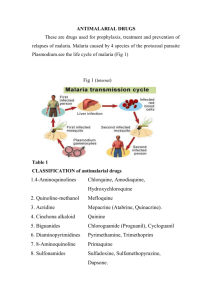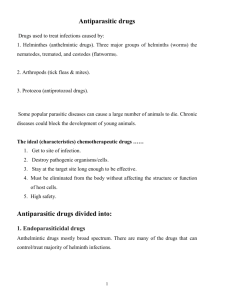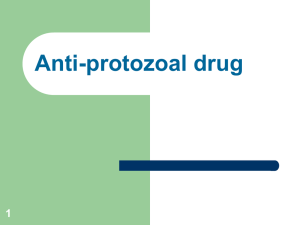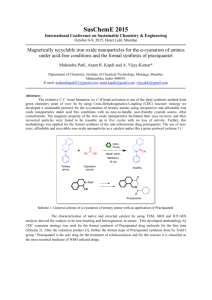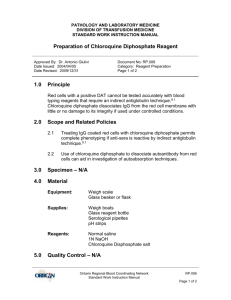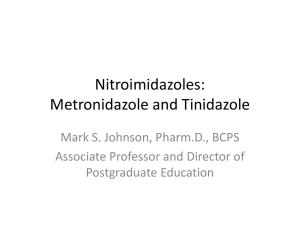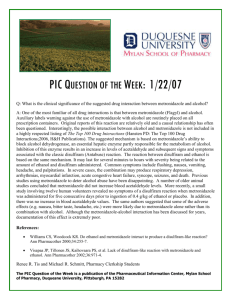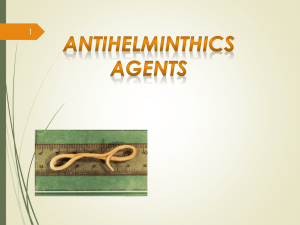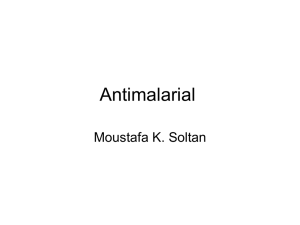Amebiasis
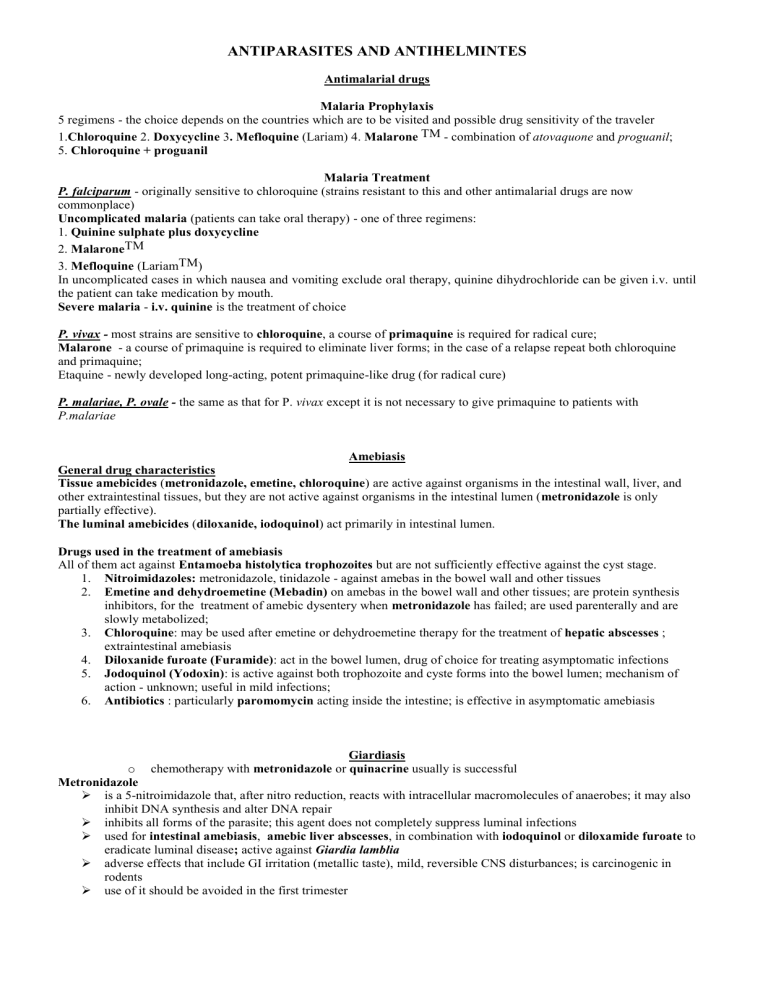
ANTIPARASITES AND ANTIHELMINTES
Antimalarial drugs
Malaria Prophylaxis
5 regimens - the choice depends on the countries which are to be visited and possible drug sensitivity of the traveler
1.
Chloroquine 2. Doxycycline 3 . Mefloquine (Lariam) 4. Malarone
TM - combination of atovaquone and proguanil ;
5. Chloroquine + proguanil
Malaria Treatment
P. falciparum - originally sensitive to chloroquine (strains resistant to this and other antimalarial drugs are now commonplace)
Uncomplicated malaria (patients can take oral therapy) - one of three regimens:
1. Quinine sulphate plus doxycycline
2. Malarone
TM
3. Mefloquine (LariamTM)
In uncomplicated cases in which nausea and vomiting exclude oral therapy, quinine dihydrochloride can be given i.v. until the patient can take medication by mouth.
Severe malaria - i.v. quinine is the treatment of choice
P. vivax - most strains are sensitive to chloroquine , a course of primaquine is required for radical cure;
Malarone - a course of primaquine is required to eliminate liver forms; in the case of a relapse repeat both chloroquine and primaquine;
Etaquine - newly developed long-acting, potent primaquine-like drug (for radical cure)
P. malariae, P. ovale - the same as that for P. vivax except it is not necessary to give primaquine to patients with
P.malariae
Amebiasis
General drug characteristics
Tissue amebicides ( metronidazole, emetine, chloroquine ) are active against organisms in the intestinal wall, liver, and other extraintestinal tissues, but they are not active against organisms in the intestinal lumen ( metronidazole is only partially effective).
The luminal amebicides ( diloxanide, iodoquinol ) act primarily in intestinal lumen.
Drugs used in the treatment of amebiasis
All of them act against Entamoeba histolytica trophozoites but are not sufficiently effective against the cyst stage.
1.
Nitroimidazoles: metronidazole, tinidazole - against amebas in the bowel wall and other tissues
2.
Emetine and dehydroemetine (Mebadin) on amebas in the bowel wall and other tissues; are protein synthesis inhibitors, for the treatment of amebic dysentery when metronidazole has failed; are used parenterally and are slowly metabolized;
3.
Chloroquine : may be used after emetine or dehydroemetine therapy for the treatment of hepatic abscesses ; extraintestinal amebiasis
4.
Diloxanide furoate (Furamide) : act in the bowel lumen, drug of choice for treating asymptomatic infections
5.
Jodoquinol (Yodoxin) : is active against both trophozoite and cyste forms into the bowel lumen; mechanism of action - unknown; useful in mild infections;
6.
Antibiotics : particularly paromomycin acting inside the intestine; is effective in asymptomatic amebiasis
Giardiasis o chemotherapy with metronidazole or quinacrine usually is successful
Metronidazole
is a 5-nitroimidazole that, after nitro reduction, reacts with intracellular macromolecules of anaerobes; it may also inhibit DNA synthesis and alter DNA repair
inhibits all forms of the parasite; this agent does not completely suppress luminal infections
used for intestinal amebiasis , amebic liver abscesses , in combination with iodoquinol or diloxamide furoate to eradicate luminal disease ; active against Giardia lamblia
adverse effects that include GI irritation (metallic taste), mild, reversible CNS disturbances; is carcinogenic in rodents
use of it should be avoided in the first trimester
Toxoplasmosis
the treatment of choice - pyrimethamine and a sulfonamide
dosage of Pyrimethamine (plus either trisulfapyrimidines or sulfadiazine); continue with this treatment for 3-4 days;
Leucovorin calcium (folinic acid), is given to avoid the hematologic effects of pyrimethamine-induced foliate deficiency
in the treatment of toxoplasmal encephalitis in AIDS, higher doses are used
Trichomoniasis
Transmission of the infection occurs primarily by sexual contact
Confirmed cases usually are treated successfully with a single course of metronidazole
Alternative therapy – other nitroheterocyclic drugs ( tinidazole )
Treatment failures often can be attributed to reinfection from an untreated partner who remains asymptomatic
TREATMENT OF HELMINTH INFECTINS
1) Nematodes (Roundworms)
Ascaris lumbricoides: mebendazol, pyrantel pamoate and albendazole preferred agents; piperazine is effective, but it is used less often because of occasional neurotoxicity and hypersensitivity reactions; mebendazol or albendazol are used in the treatment of mixed infections, because these agents are particularly effective against Ascaris and both species of hookworms; Pyrantel pamoate is an acceptable alternative, because it does not possess the teratogenic potential of the benzoimidazole
Trichinella spiralis : albendazole and other benzoimidazoles are effective against the intestinal forms T. spiralis that are present early in infection; the efficacy of these agents or any antyhelmintic agent on larvae that have migrated to muscle is questionable; corticosteroids may be of considerable value in controlling the acute and dangerous manifestations of established infection
Hookworm: Necator americanus, Ancylostoma duodenale : in treatment we have two related objectives:
the first is to restore the blood values to normal (proper diet and treatment with iron are usually sufficient, but blood transfusion is required occasionally ) ,
the second objective – to expel the intestinal parasites– mebendazole and albendazole are agents of the first choice against the both species; both agents have the advantage of effectiveness against other roundworms when there is multiple infection
Enterobius vermicularis : mebendazole, albendazole and pyrantel pamoate are highly effective; when their use is combined with standards of personal hygiene, a high proportion of cures can be obtained
2) Cestodes (Flatworms)
Taenia saginata: Praziquantel and niclosamide - drugs of choice ; Taenia solium : Praziquantel preferred over niclosamide
Albendazole and Praziquantel - drugs of choice for treating cysticercosis
Diphyllobothrium latum : there is deficiency of vitamin B12 (results from use of the vitamin by the worm, and expulsion of the worm results in haematological remission ; Praziquantel or niclosamide - drug of choice for treatment;
Hymenolepsis nana : treatment must be adapted to form of development; Praziquantel or niclosamide
3) Trematodes (Flukes): Schistosoma haematobium, Schistosoma mansoni, Schistosoma japonicum
Praziquantel drug of choice for schistosomes; safe and effective when is given in single or divided oral doses on the same day
